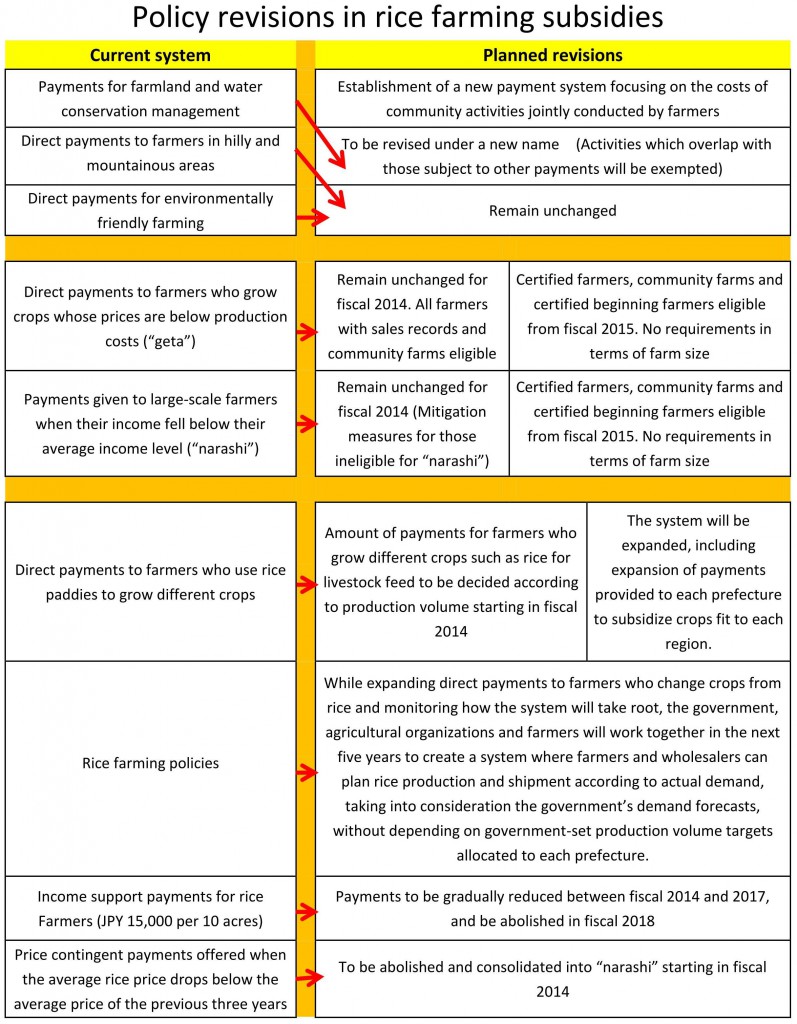The Ministry of Agriculture, Forestry and Fisheries on Wednesday, November 6, proposed revising the rice production adjustment program and abolishing subsidies paid to farmers who meet the limit in rice paddy usage.
The plan, unveiled during a meeting of the Liberal Democratic Party’s agricultural policies project team, stated that starting next year, the government would gradually cut subsidies of JPY 15,000 per 10 ares offered to rice farmers who have managed to reduce paddy usage to meet government-set goals. The subsidies would eventually disappear in fiscal 2018.
To make up for the cut in the subsidies offered to rice farmers, the ministry suggested expanding subsidies paid to those who changed to different crops such as rice for livestock feed.
The ministry hopes that under the new system, farmers will secure income and grow rice according to demand without depending on the government’s production volume targets allocated to each prefecture. But lawmakers of the project team, many of whom represent rice-growing rural areas, expressed deep concerns over the reform proposals which were compiled with strong backing from the private sector.
The proposals will be the first major agricultural policy shift since the Democratic Party of Japan introduced the individual-household income compensation system in fiscal 2010 when it was in power. They will be discussed among the LDP and then at the government’s Industrial Competitiveness Council, and eventually be included in the government’s agricultural revitalization plan, which is expected to be announced in late November or early December.
 Through the new system, the ministry intends to encourage farmers to voluntarily reduce production of rice whose consumption as a staple food is declining and change to rice for livestock feed and other crops with stable demand. In order to offer an incentive for expanding production of other crops, the ministry plans to introduce a system of changing the amount of subsidies according to production volume.
Through the new system, the ministry intends to encourage farmers to voluntarily reduce production of rice whose consumption as a staple food is declining and change to rice for livestock feed and other crops with stable demand. In order to offer an incentive for expanding production of other crops, the ministry plans to introduce a system of changing the amount of subsidies according to production volume.
In order to prove the effectiveness of the new system and secure farmers’ income, the LDP must seek ways to stimulate demand for rice for livestock feed and establish a distribution system for such rice.
Although the ministry suggested gradually cutting subsidies paid to rice farmers who meet the production target over the next four years to reduce negative impact on farmers, the specific amount of subsidies for each year is yet to be decided.
The ministry also plans to abolish subsidies to compensate drop in rice prices starting in fiscal 2014 and integrate them to subsidies given to large-scale farmers when their income fell below their average income level, the measure commonly called “narashi.” Eligibility requirements for “narashi” subsidies will be relaxed from fiscal 2015, and meanwhile, mitigation measures will be taken for those ineligible for “narashi.”
It also proposed expanding the current funding program which gives each prefecture free hand to subsidize production of crops which are suited to each region and which they want to promote, provided that local governments put together concrete schemes to fully utilize rice paddies. The ministry plans to let prefectures use the funds also to subsidize farmers who start growing high-yielding variety of rice for livestock feed.
The ministry stated that the government, agricultural organizations and farmers will work together in the next five years to create a system where farmers and wholesalers can plan rice production and shipment according to actual demand, taking into consideration the government’s demand forecasts.
(Nov. 7, 2013)

